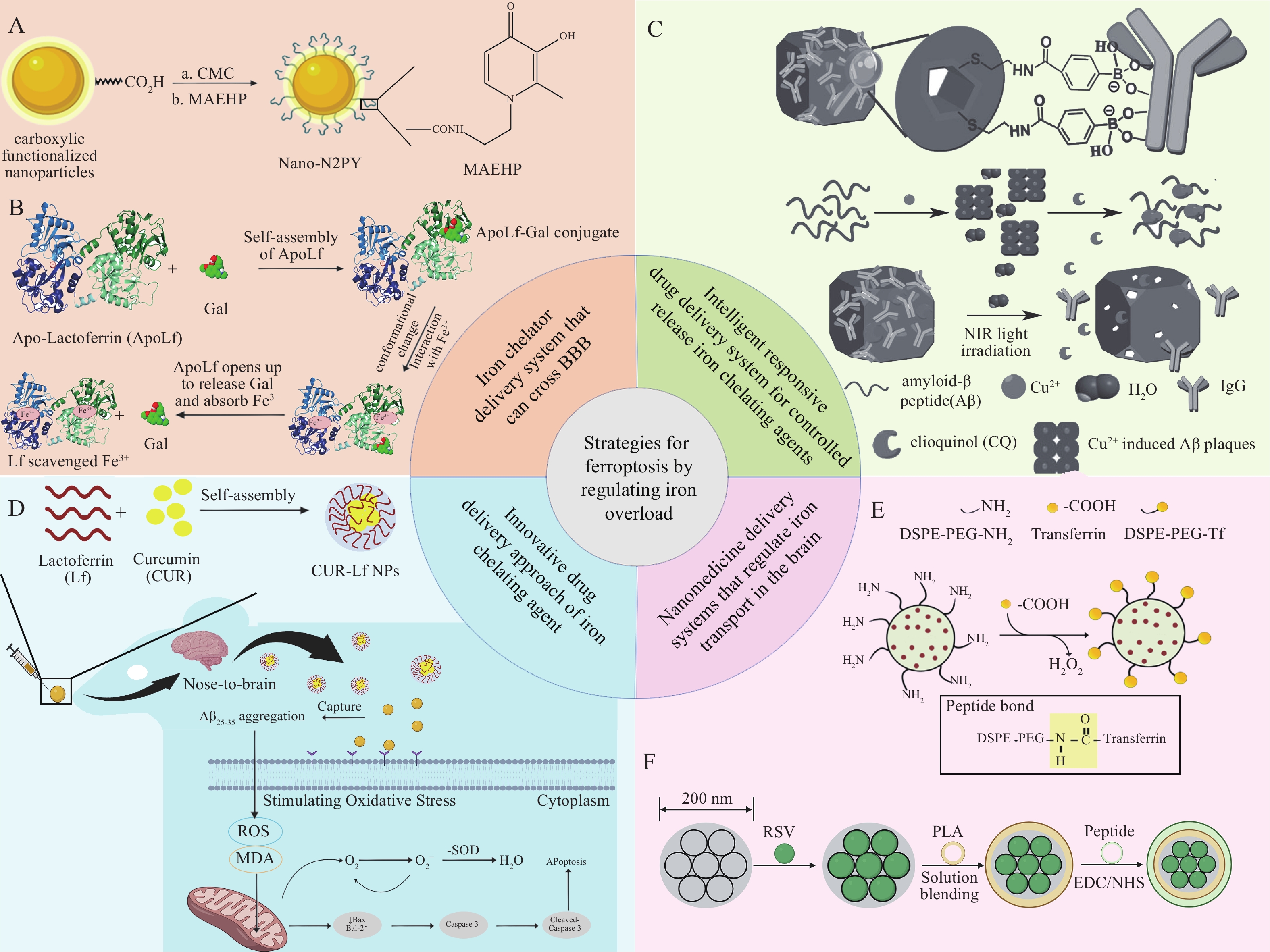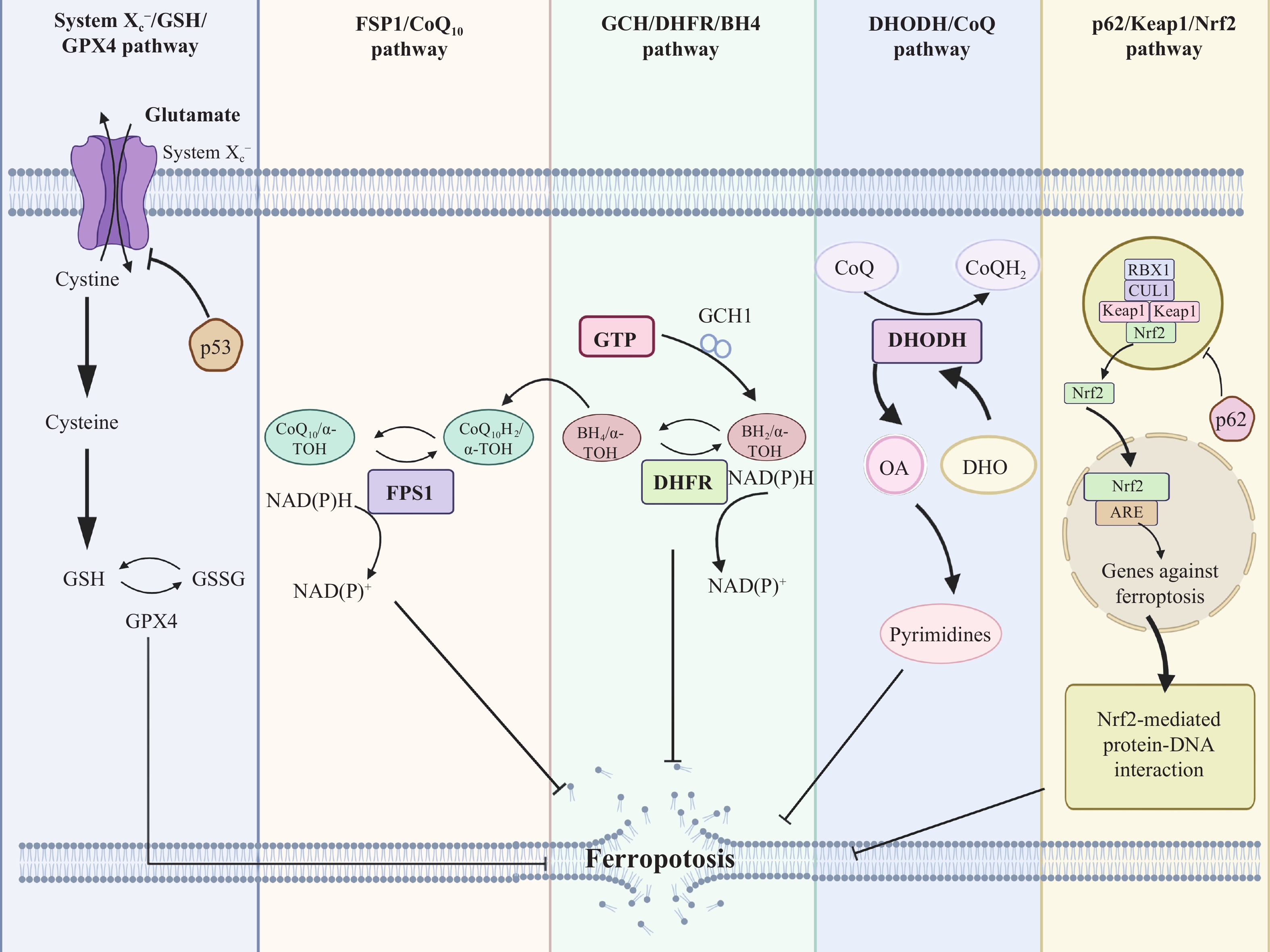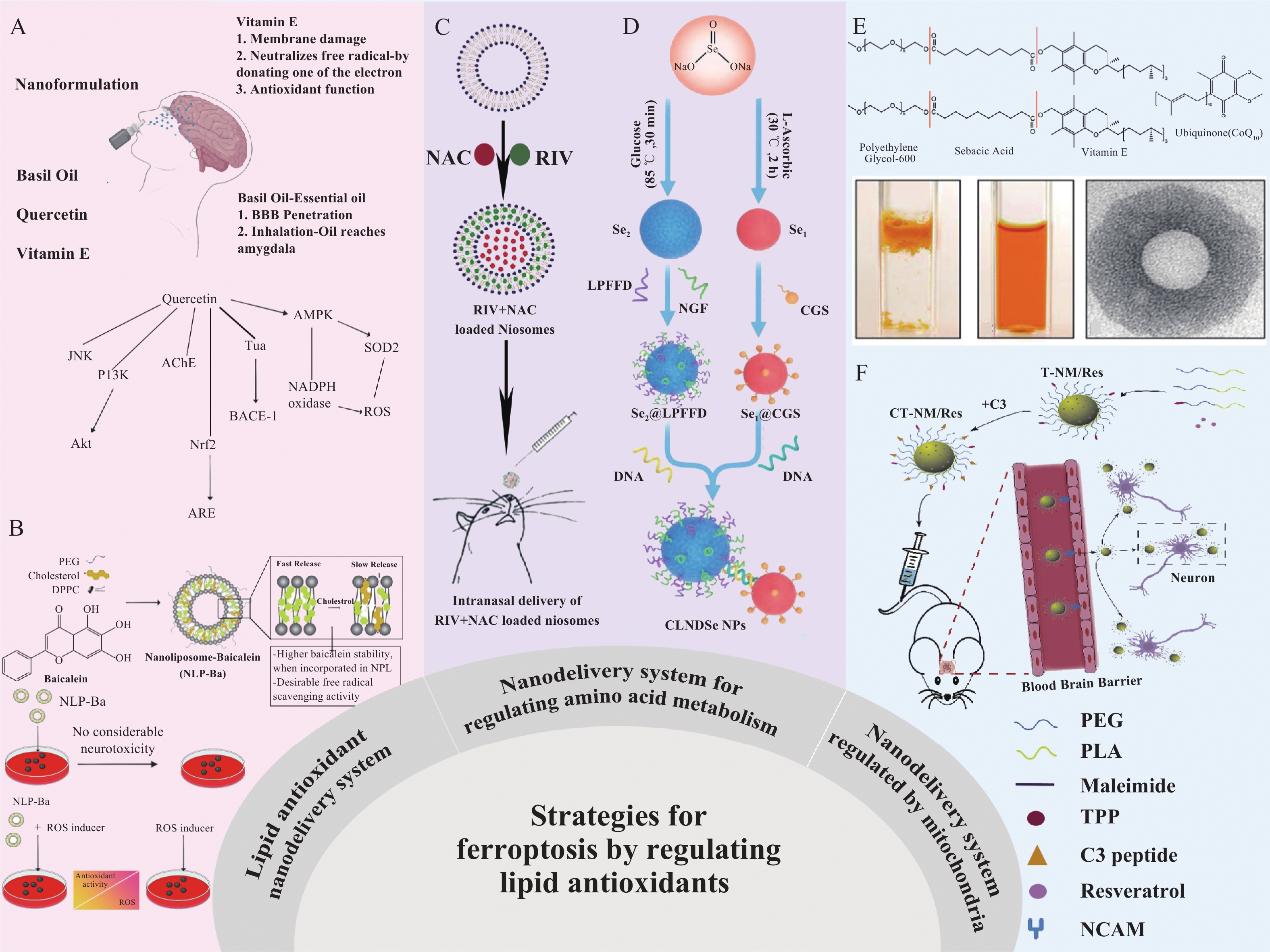Advances in anti-Alzheimer’s disease nano drug delivery system based on pathogenic mechanism of ferroptosis
-
摘要:
铁死亡是一种铁依赖性脂质过氧化和活性氧过度积累诱发的程序性细胞死亡方式,被证明是阿尔茨海默病(Alzheimer’s disease,AD)进展过程中神经元死亡的关键病理机制,形成AD致病“铁死亡假说”。近年,基于铁死亡致病机制的AD治疗研究主要为脑内铁代谢和微环境氧化还原失衡调控,但血脑屏障及脑内复杂病理环境限制了药物脑内转运、分布及治疗效果,对药物递送技术提出了新要求。本综述在阐述细胞铁死亡过程及其调控机制的基础上,探讨了铁过载和氧化还原失衡与神经元丢失及AD进展的相关性,并基于铁过载和氧化还原失衡综述了抗AD纳米药物递送系统研究进展,为AD治疗和新药研发提供新思路。
Abstract:Ferroptosis, a programmed cell death induced by iron-dependent lipid peroxidation and excessive accumulation of reactive oxygen species, is a key pathological mechanism of neuronal death during the progression of Alzheimer’s disease (AD), contributing to the formation of “Ferroptosis Hypothesis” for AD pathogenesis. In recent years, there has been extensive research on therapeutic strategies for AD based on the pathogenic mechanism of ferroptosis, focusing primarily on the dysregulation of brain iron metabolism and redox regulation in microenvironment. However, presence of blood-brain barrier and intricate pathological environment within brain impose limitations on intracranial drug transportation, distribution and therapeutic efficacy, thereby necessitating advancements in drug delivery technology. Based on description of ferroptosis process and its regulatory mechanisms, this review explores the association between iron overload and redox imbalance with neuronal loss and AD development, and additionally, summarizes the advancements in nano drug delivery systems targeting iron overload and redox imbalance for potential anti-AD treatments, so as to offer some novel perspectives for AD treatment and drug development.
-
阿尔茨海默病(Alzheimer’s disease,AD)是一种起病隐匿的神经系统退行性疾病,患病率和病死率逐年攀升且呈年轻化趋势。据统计,我国AD患者占全球患者总量的1/4,社会经济负担日益加重,AD已成为严重危害我国人民健康的重大社会问题[1]。神经元损伤与丢失是AD治疗中的关键问题,且阐明神经元死亡机制是探究AD治疗方案的重点。依托近年基因组学、CRISPR基因编辑技术、诱导多能干细胞(iPSC)等技术平台的发展,对正常生理和AD病理下神经元开展全基因组筛选,发现铁死亡关键调节因子谷胱甘肽过氧化物酶4(glutathione peroxidase 4,GPX4)及其合成通路相关基因表达水平是AD病灶神经元存活的关键。此外,AD退变病区的铁蓄积也是铁死亡的重要病理特征之一。Ayton 等[2]首次提出了AD的“铁死亡假说”,指出铁死亡是AD发病的重要机制。铁死亡是一种铁依赖性且区别于细胞凋亡、细胞坏死、细胞自噬的新型细胞程序性死亡方式,其特征在于铁依赖性脂质过氧化,最终导致氧化应激和细胞死亡。研究表明,抑制神经元铁死亡可有效改善AD患者认知功能障碍症状及神经元进行性丢失。因此,基于铁死亡致病机制抗AD途径为AD治疗提供了新思路。
铁死亡的核心是铁代谢紊乱和氧化还原稳态失衡。脑内铁代谢稳态对维持大脑正常生理功能至关重要,铁参与髓鞘形成、神经递质合成等重要生理过程,其进出受到转铁蛋白结合铁途径、非转铁蛋白结合铁途径和膜铁转运蛋白1(ferroportin-1,FPN1)外排途径等多种分子机制的严格控制。神经元内铁有两种存在形式,游离二价铁在神经元细胞质中参与代谢,同时部分铁以无毒三价铁形式储存在铁蛋白中。当神经元内铁含量低时,铁蛋白被溶酶体降解释放游离铁,以满足神经元的铁代谢需求;而当神经元内铁含量过高时,则可通过铁转运蛋白FPN1将多余铁排出胞外。AD病理环境下,神经元铁吸收增加,铁外排受阻,最终导致铁代谢失衡,病理表现为AD患者大脑海马、皮质叶和基底神经节区域铁含量升高。AD病灶铁蓄积促进β-淀粉样蛋白(amyloid β-protein,Aβ)斑块和磷酸化Tau蛋白形成神经原纤维缠结(neurofibrillary tangle,NFT)的错误折叠过程,而Tau蛋白的过度磷酸化和聚集反过来抑制铁外排导致铁的进一步蓄积,形成AD致病恶性循环[3]。
维持氧化还原稳态是保持神经元正常生理功能的关键。然而,AD患者神经元内过量铁引发芬顿反应产生大量活性氧(reactive oxygen species,ROS),导致胞内微环境氧化还原平衡失调,促进生物膜中多不饱和脂肪酸(PUFA)结构过氧化,进而诱发铁死亡。神经元内存在天然抗氧化系统,如GPX4可利用谷胱甘肽(glutathione,GSH)将有毒的脂质过氧化物转化为无毒的脂质醇,抵抗神经元铁死亡。在AD病灶中,突变型早老素会显著抑制GPX4表达;同时,病灶Aβ沉积也会导致神经元内GSH含量降低,降低GPX4介导脂质过氧化物还原能力,加剧氧化应激与神经元铁死亡,最终造成神经元进行性丢失及海马退行性病变[4]。因此,本文重点围绕重塑铁代谢稳态与氧化还原稳态两个方面对基于铁死亡致病机制的抗AD纳米药物递送系统展开综述。
1. 铁代谢失衡调控的纳米药物递送系统
重塑脑内铁代谢失衡是抑制神经元铁死亡、延缓或逆转AD病程的有效策略。目前,调控铁代谢失衡的主要措施包括铁螯合剂清除蓄积铁和逆转脑内铁转运。其中,铁螯合剂去铁酮治疗AD已完成临床Ⅱ期试验,有效降低了AD患者脑内铁水平,并改善患者认知功能;调控铁调素等铁转运关键分子,可抑制铁的跨血脑屏障(blood-brain barrier,BBB)脑内转运,并促进神经元内蓄积铁外排,有效逆转神经元铁死亡。但以上策略的疗效及安全性受到药物脑内分布效率的限制,亟须开发增效减毒的纳米药物递送系统。
1.1 铁螯合纳米药物递送系统
络合作用是缓解神经元及脑内微环境铁蓄积的直接策略。铁螯合剂将脑内过量的铁转化为螯合物,降低游离铁水平;产生的铁螯合物结构稳定,具有良好化学及生物惰性,可以有效阻断芬顿反应等毒性反应的发生。铁螯合剂虽能通过抑制神经元铁死亡有效改善AD患者认知行为表现和减缓神经退行性病变进程,但其不良反应和低BBB透过率等问题限制了临床应用。例如,FDA批准的六齿铁螯合剂去铁胺(deferoxamine,DFO)具有强亲水性,不易透过BBB,生物利用度低,临床用药需通过长期皮下/肌肉大剂量给药维持其稳定疗效,但长期用药会诱发外周铁过度清除,导致视力障碍等不良反应。为此,开发脑靶向给药系统有望提高药物疗效,并减少药物不良反应发生。
1.1.1 铁螯合剂跨BBB给药系统
BBB作为机体重要生理屏障,主要由脑微血管内皮细胞、星形胶质细胞、小胶质细胞和周细胞共同构成,其选择透过性能够防止有害物质进入大脑,维持大脑内环境稳态,但也阻碍了铁螯合剂等治疗药物的脑内递送。研究发现,将铁螯合剂与纳米颗粒共价偶联构建螯合剂-纳米颗粒系统,可吸附载脂蛋白,通过低密度脂蛋白受体介导的转胞吞作用跨越BBB,实现脑内高效递送。此外,铁螯合剂与纳米粒的结合可有效促进铁螯合复合物外排,保证了AD治疗的安全性和有效性。例如,羧酸官能化聚乳酸-羟基乙酸共聚物(PLGA)纳米粒与1-环己基-2-吗啉乙基碳二亚胺甲基对甲苯磺酸盐(CMC)在2-(N-吗啉基)乙烷磺酸(MES)缓冲溶液在室温下活化羧基,与2-甲基-N-(2′-氨基乙基)-3-羟基-4-吡啶酮(MAEHP)偶联形成复合物Nano-N2PY(图1-A)。该复合物在循环系统中与载脂蛋白结合形成复合物,利用低密度脂蛋白受体介导的转胞吞作用穿越BBB将铁螯合剂递送至脑内。螯合脑内过量的铁,阻断神经元铁死亡,并有效抑制Aβ聚集,保护神经元细胞免受Aβ相关的神经毒性,缓解症状的同时延缓AD病程[5]。
![]() Figure 1. Anti-ferroptosis strategies by alleviating iron overloadA: Synthesis of PLGA nanoparticle-chelator conjugate (Nano-N2PY)[5]; B: Schematic diagram of Lactoferrin-galantamine (Lf-Gal) nanoparticle fabrication, and corresponding Gal release upon iron absorption[8]; C: Structure illustration of IgG capped gold nanocage (AuNC-IgG) and photothermal-responsive H2O2-fueled release of guest molecules clioquinol (CQ) from AuNC-IgG[9]; D: Schematic illustration of curcumin-lactoferrin nanoparticles (CUR-LF NPs) preparation, and neuroprotection mechanism of CUR-LF NPs via intranasal administration[10]; E: Fabrication of transferrin-functionalization of nanoparticle[14]; F: Resveratrol (RSV) loaded mesoporous silica nanoparticle with Ac-[cMPRLRGC]c-NH2 peptide modification on surface[15]
Figure 1. Anti-ferroptosis strategies by alleviating iron overloadA: Synthesis of PLGA nanoparticle-chelator conjugate (Nano-N2PY)[5]; B: Schematic diagram of Lactoferrin-galantamine (Lf-Gal) nanoparticle fabrication, and corresponding Gal release upon iron absorption[8]; C: Structure illustration of IgG capped gold nanocage (AuNC-IgG) and photothermal-responsive H2O2-fueled release of guest molecules clioquinol (CQ) from AuNC-IgG[9]; D: Schematic illustration of curcumin-lactoferrin nanoparticles (CUR-LF NPs) preparation, and neuroprotection mechanism of CUR-LF NPs via intranasal administration[10]; E: Fabrication of transferrin-functionalization of nanoparticle[14]; F: Resveratrol (RSV) loaded mesoporous silica nanoparticle with Ac-[cMPRLRGC]c-NH2 peptide modification on surface[15]抗体偶联策略是临床上将抗体与药物分子共价连接起来的靶向递药技术。受此启发,将铁螯合剂与BBB上高表达转运受体的配体相偶联形成复合物,通过受体介导将铁螯合剂递送入脑,是提高铁螯合剂脑内递送效率的有效策略。乳铁蛋白受体在BBB和神经元表面均呈高表达,采用其天然配体乳铁蛋白(lactoferrin,Lf)与药物偶联,所得复合物通过受体介导的转胞吞作用跨越BBB,并进一步高效靶向神经元[6]。如将铁螯合剂地拉罗司与Lf共价偶联形成复合物[7],显著提高了地拉罗司的BBB透过率,显著降低脑内铁水平,抑制神经元铁死亡,改善认知障碍。Lf除了作为靶向神经元的有效配体,还是一种对铁具有很强亲和力的糖蛋白,参与铁运输并调节铁稳态。利用Lf的铁结合能力可有效降低AD患者脑内铁过载,抵抗AD患者脑内神经元铁死亡。Akilo等[8]提出了一种将Lf与AD治疗药物加兰他敏(Gal)联用的AD治疗策略(图1-B)。未与铁结合的Lf可通过自组装将Gal分子封装在蛋白空腔内形成纳米复合物,当复合物转运至AD患者大脑中,Lf与高水平的游离铁相互作用而发生构象转变,释放空腔中包封的Gal,提高乙酰胆碱神经递质浓度,缓解认知障碍症状;同时,Lf与铁快速结合清除脑内过载的铁,抑制神经元铁死亡。该策略实现了“神经保护-递质治疗”的协同作用,在缓解认知障碍症状的同时有效保护神经元,避免神经元丢失,延缓AD疾病进程。
1.1.2 智能响应控释铁螯合剂给药系统纳米颗粒
铁螯合剂递送技术和共价偶联策略虽能提高铁螯合剂的脑内递送效率,但铁螯合剂暴露在外,对循环系统中铁具有一定的螯合清除作用,难以避免破坏外周铁稳态。因此,将铁螯合剂包封于纳米载体内部,并引入智能响应控释载体结构设计,在提高铁螯合剂的靶向性和生物利用度的同时也提高了铁螯合剂治疗安全性。Shi等[9]利用芳基硼酸酯具有热敏性和氧化还原性双重响应特性,以金纳米笼(AuNC)为基材开发了新型双响应笼状金属螯合剂递释系统(图1-C),以实现铁螯合剂的病灶有效控释,提高铁螯合剂的用药安全性。该系统将2-氨基乙硫醇接枝到AuNC表面制备成氨基官能化AuNC(AuNC-NH2),将苯硼酸与AuNC-NH2缩合,得到苯硼酸官能化的AuNC(AuNC-PBA)。AuNC内部中空、表面多孔并具有近红外区域(NIR)可调的局部表面等离子体共振吸收,可将近红外光高效转化为热量。在近红外辐射条件下,AuNC的光热效应与芳基硼酸酯的氧化还原响应协同作用,实现药物的有效控释,显著抑制了Aβ聚集体的形成,降低神经元ROS蓄积,避免神经元铁死亡;同时可以维护外周铁稳态,保证铁螯合剂递送的安全性。
1.1.3 铁螯合剂创新给药途径
除了经血液跨越BBB给药途径外,BBB旁路给药途径(如鼻腔给药、经内耳给药等)则可以绕过BBB和血脊液屏障,实现药物高效递送入脑。其中鼻腔给药经过嗅神经通路直接到达脑部,有效避免铁螯合剂对于外周铁水平的影响,提高铁螯合剂的生物利用度与安全性。采用脱溶剂法将姜黄素(CUR)包封于Lf的疏水空腔中构建CUR-Lf纳米颗粒(CUR-Lf NPs)(图1-D)[10]。该纳米递药系统经鼻腔给药后可经过嗅神经等“鼻→脑”通路快速、高效入脑,并由Lf受体介导被神经元高效摄取;释药后Lf高效结合细胞内的游离铁,降低铁蓄积水平,避免神经元发生铁死亡;并与CUR介导抗脂质过氧化及抗凋亡作用协同发挥神经元保护功能。鼻腔给药是实现脑内高效药物递送的创新给药途径,其绕过BBB提高药物脑内富集效率,显著延长了CUR-Lf NPs的脑内消除半衰期,提高其生物利用度,并且通过螯合脑内铁和降低脑内脂质过氧化双重作用抵抗铁死亡保护神经元。
1.2 调节脑内铁转运纳米药物递送系统
在AD患者病灶脑区,铁含量异常升高的关键原因在于,BBB上的铁转运蛋白上调,导致大脑铁摄取增加,同时脑内唯一的铁外排蛋白FPN1外排能力减弱,进而导致脑内铁代谢失衡,造成脑内铁蓄积。脑内过量的铁继而引发芬顿反应,导致氧化应激诱发神经元的铁死亡。铁调素作为铁代谢的关键负性调节剂,可以抑制BBB和神经元中铁转运蛋白的表达,从而减少脑内铁摄取[11]。研究表明,铁调素可以通过调节BBB铁转运蛋白防止大脑中的铁过载,进而抵抗神经元铁死亡以治疗AD。在APP/PS1模型小鼠中过表达的铁调素显著降低了大脑皮层和海马体脑区的神经元内铁蓄积水平,抑制了神经元铁死亡,且与对照组相比,铁调素过表达小鼠脑内的皮质神经元和海马体神经元存活率均有所上升[12]。该研究表明过表达铁调素是降低脑内铁过载,防止脑内神经元丢失以逆转AD病程的有效策略。
除基因水平干预手段外,小分子药物如多酚类药物等也被证明可上调铁调素水平,缓解脑内铁蓄积。槲皮素(QU)和白藜芦醇(RSV)等可通过核因子2相关的红系因子2(nuclear factor erythroid-2 related factor 2,Nrf2)通路上调铁调素水平[13],但QU和RSV等小分子药物的稳定性和脑内分布效率不高,限制了其临床应用。内源性受体转运途径可以提高小分子药物的生物利用度,将小分子药物包裹进转铁蛋白等配体修饰的纳米粒中,通过配体-受体结合途径实现受体介导的脑内高效递药。Pinheiro等[14]将脂质纳米粒与转铁蛋白偶联开发出负载QU的转铁蛋白官能化脂质纳米颗粒(图1-E),在纳米颗粒表面用转铁蛋白进行修饰形成转铁蛋白官能化的纳米颗粒,可以提高QU的生物利用度和脑内选择性递送效率。实验结果表明,该脂质纳米颗粒可以有效提高QU的稳定性,并且具有高BBB透过率,上调脑内铁调素水平,减少神经元内铁摄取,同时降低了神经元内脂质过氧化物的累积,逆转神经元铁死亡,进而有效延缓AD病程。与之类似,针对BBB上高表达的LDLR设计的配体多肽Ac-[cMPRLRGC]c-NH2被用于RSV的脑内递送。LDLR配体多肽修饰介孔二氧化硅纳米颗粒可高效负载RSV(图1-F),经静脉给药后通过受体介导的转胞吞作用主动跨越BBB,在AD病灶微环境ROS刺激下快速释放RSV,上调铁调素水平,减少神经元内铁摄取,同时抵抗神经元内发生脂质过氧化,具有高效抗神经元铁死亡的AD治疗潜力[15]。
2. 微环境氧化还原调控的纳米药物递送系统
在AD病理条件下,脑内过量的铁会引发ROS蓄积和脂质过氧化,导致氧化还原稳态失衡。内源抗氧化系统具有修复微环境氧化还原稳态的潜能。调控氨基酸代谢和线粒体代谢可以作为抗氧化系统的主要调节通路,减少ROS累积和脂质过氧化的发生。目前已发现通过调控氧化还原稳态调节铁死亡的通路为氨基酸代谢相关通路、线粒体代谢相关通路和细胞核内转录调控通路[16](图2)。作为细胞内最重要的铁死亡调控通路,System Xc-/GSH/GPX4通路与细胞内氨基酸代谢相关,其调控机制为谷氨酸和胱氨酸通过System Xc-等量交换,胱氨酸在细胞内转化为半胱氨酸生成GSH,GPX4依赖于GSH将脂质过氧化物还原为脂质醇,减少细胞内脂质过氧化。线粒体代谢相关的通路包括FSP1/CoQ10通路、GCH1/DHFR/BH4通路和DHODH/CoQ通路。其中FSP1/CoQ10通路与DHODH/CoQ通路均依赖于辅酶Q(CoQ),通过将线粒体内膜上的CoQ还原为CoQH2逆转线粒体代谢功能障碍。与上述两种通路不同,GCH1/DHFR/BH4通路是依赖于四氢生物蝶呤(BH4)的自由基清除功能在细胞内发挥抗氧化作用。BH4氧化态和还原态之间的相互转化由GTP环化水解酶-1(GCH1)和二氢叶酸还原酶(DHFR)控制。GCH1通过产生亲脂性抗氧化剂BH4防止脂质过氧化,选择性阻止PUFA-PL耗竭诱导的膜脂重构。DHFR是BH4再生的必需酶,其抑制可能与GPX4抑制剂协同诱导铁死亡。Nrf2是直接与抗氧化反应元件(ARE)结合的主要核转录因子,基于Nrf2的p62/Keap1/Nrf2通路在氧化损伤条件下,p62阻止Keap1-CUL3-RBX1 E3泛素连接酶复合体中Nrf2的降解,Nrf2发生核转位,启动多种细胞保护基因的转录以抵抗铁死亡。
综上所述,基于细胞内氧化还原稳态调控通路,设计开发的重建氧化还原平衡以抵抗神经元铁死亡的AD治疗策略主要有:(1)抗脂质过氧化;(2)调控氨基酸代谢;(3)调控线粒体代谢(图3)。
![]() Figure 3. Anti-ferroptosis strategies by regulating lipid peroxidation in neuronA: Intranasal administration of quercetin, vitamin E, and basil oil for anti-oxidation[17]; B: Preparation of baicalein (Ba) loaded nanoliposome (NLP-Ba) and antioxidation of NLP-Ba neuroprotection[20]; C: Fabrication and intranasal administration of N-acetylcysteine (NAC) and rivastigmine (RIV) co-loaded niosomes[24]; D: Synthesis route of multifunctional double selenium nanosphere (CLNDSe)[29]; E: Formulation and characterization of CoQ10-loaded nano-micelle (Ubisol-Q10)[35]; F: Schematic illustration of micelles co-modified with neural cell adhesion molecule (NCAM) mimetic peptide C3 and triphenylphosphonium (TPP) for targeting the mitochondria of the central neurons, reversing mitochondrial dysfunction[37]
Figure 3. Anti-ferroptosis strategies by regulating lipid peroxidation in neuronA: Intranasal administration of quercetin, vitamin E, and basil oil for anti-oxidation[17]; B: Preparation of baicalein (Ba) loaded nanoliposome (NLP-Ba) and antioxidation of NLP-Ba neuroprotection[20]; C: Fabrication and intranasal administration of N-acetylcysteine (NAC) and rivastigmine (RIV) co-loaded niosomes[24]; D: Synthesis route of multifunctional double selenium nanosphere (CLNDSe)[29]; E: Formulation and characterization of CoQ10-loaded nano-micelle (Ubisol-Q10)[35]; F: Schematic illustration of micelles co-modified with neural cell adhesion molecule (NCAM) mimetic peptide C3 and triphenylphosphonium (TPP) for targeting the mitochondria of the central neurons, reversing mitochondrial dysfunction[37]2.1 脂质抗氧化剂纳米递送系统
在AD病灶中,过量脂质过氧化物累积是神经元铁死亡的直接诱因。在被氧化的脂质中,疏水尾部为PUFA的磷脂尤为关键。PUFA容易发生自由基链式反应,产生大量脂质过氧化物。抗氧化剂既可以中和自由基,阻止自由基链式反应的发生,减少脂质过氧化物累积,也可以作用于ROS,减少ROS诱导的脂质过氧化,抵抗铁死亡。维生素E作为人体细胞膜中必需的抗氧化剂,可有效阻止自由基的传播,从而保护细胞膜,并减少各种有害的氧化产物。将维生素E与其他抗氧化剂联用进行鼻内递送是协同抗脂质氧化治疗AD的有效策略。以维生素E作为油相形成载药纳米乳液降低了维生素E单独用药的潜在毒性,并且通过鼻腔给药可成功跨越BBB实现高效脑内递送(图3-A)[17]。此外,研究人员将维生素E衍生物生育酚聚乙二醇琥珀酸酯(TPGS)与聚酰胺-胺(PAMAM)树形分子通过碳二亚胺反应偶,并联负载胡椒碱(PIP),构建PIP-TPGS-PAMAM递药系统[18]。TPGS作为维生素E的衍生物可以清除自由基,抵抗ROS诱导的脂质过氧化反应,保护细胞免受Aβ毒性影响;同时表面修饰TPGS可显著改善纳米载体穿越BBB的能力,提高了药物的脑组织分布效率。实验结果表明,PIP-TPGS-PAMAM显著降低了小鼠海马体中神经元丢失,并有效减少Aβ1-42的含量,具有减轻AD引起的认知功能障碍的治疗活性。
天然植物中提取的抗氧化剂,也可以有效地减少脂质过氧化的发生。QU作为天然提取的类黄酮,可通过调节Nrf2的表达水平,促进细胞内抗氧化酶的合成和释放,降低细胞内ROS水平,减少脂质过氧化;此外,QU还可抑制Aβ 的沉积。但是由于稳定性差和溶解度低,QU生物利用度不高。采用缬氨酸改性的聚合物纳米载体共同递送QU和胆碱酯酶抑制卡巴拉汀(RIV)剂构建RIV/QU-NCs@VLCS给药系统,缬氨酸与BBB表面高表达的大型中性氨基酸转运蛋白1(LAT1)相结合通过转胞吞作用将该纳米载体递送入脑,同时该纳米载体表面修饰的壳聚糖同时可以打开BBB的紧密连接,提高载体跨越BBB效率。抗氧化剂与胆碱酯酶抑制剂的联用,有效抑制了神经元内的氧化应激,减少了脂质过氧化物的累积,抵抗神经元铁死亡的发生。实验结果表明,RIV/QU-NCs@VLCS给药系统有效缓解了神经元脂质过氧化,改善了AD模型小鼠的认知能力[19]。黄芩素(baicalein,Ba)与QU类似,也是良好的抗氧化剂可以减少脂质过氧化物的累积,采用中性电荷纳米脂质体(NLP)装载黄芩素构建NLP-Ba纳米递药系统,可促进黄芩素内化至细胞内(图3-B),高效清除神经变性过程中产生的自由基,减少脂质过氧化,逆转神经元铁死亡,增强黄芩素治疗AD的疗效,同时表现出良好的生物相容性[20]。
2.2 氨基酸代谢调控脂质过氧化的纳米药物递送系统
氨基酸代谢调控铁死亡的核心是System Xc-和GPX4参与的GSH合成和利用。GSH在GSH合成酶和谷氨酸半胱氨酸连接酶的催化下由通过System Xc-交换的半胱氨酸、甘氨酸和谷氨酸合成,GPX4依赖于GSH清除细胞中存在的过氧化物,在减少脂质过氧化反应和抗氧化应激方面具有显著的效果。在AD病灶中,GSH耗竭增加细胞中有毒脂质过氧化物的蓄积,同时GPX4水平下降导致脂质过氧化物还原能力减弱,引发体内氨基酸代谢失衡,脂质过氧化物积聚,氧化损伤增加,诱导神经元铁死亡。因此,基于改善氨基酸代谢调控脂质过氧化的策略主要为逆转GSH耗竭和提高GPX4水平。
2.2.1 逆转GSH耗竭调控脂质过氧化的纳米药物递送系统
AD病理过程中,大脑中脂质过氧化物的水平显著升高,机体还原系统过度利用GSH,造成GSH耗竭,无法进一步清除脂质过氧化物,其过量蓄积进而引发神经元铁死亡;此外,GSH耗竭神经元产生晚期糖基化终末产物(AGEs)诱导磷酸化Tau蛋白和Aβ寡聚体的糖基化,从而加剧磷酸化Tau蛋白和Aβ的毒性,同时GSH耗竭产生的丙烯醛也具有神经毒性,参与AD病理过程[21]。因此,上调脑内GSH水平也具有抑制铁死亡治疗AD的潜力。Paka等[22]利用巯基-马来酰亚胺点击反应合成了负载CUR的GSH功能化PLGA纳米颗粒(GSH-NPs-CUR),实现GSH和CUR共递送。同时,GSH还是BBB上兴奋性氨基酸转运蛋白EAAC1的天然配体,因此,GSH偶联在纳米颗粒表面可以协助递送系统跨越BBB,提高药物脑内分布效率;并且其介导的内吞过程可绕过溶酶体途径,避免药物被降解破坏。因此,GSH-NPs-CUR可以改善CUR的BBB透过率,增强神经元对于CUR的摄取率,提高其生物利用度。体内外实验结果表明,GSH-NPs-CUR给药系统通过逆转GSH耗竭,促进脂质过氧化物清除,有效抑制了神经元铁死亡,具有良好的抗AD疗效。
虽然直接补充GSH是逆转GSH耗竭最快速有效的途径,但是GSH稳定性差,具有较高的酶降解速率,降低了其生物利用度,限制了GSH的临床应用。N-乙酰半胱氨酸(NAC)是GSH的前体化合物,其稳定性好且易被机体吸收进入细胞内,可上调脑内GSH水平,缓解AD模型动物的空间记忆功能障碍和突触可塑性障碍,被广泛认为是治疗AD等神经退行性疾病的潜在药物[23]。Kulkarni等[24]开发了一种AD治疗药物卡巴拉汀(RIV)与NAC经鼻联合给药的递送策略(图3-C),采用类脂囊泡共载RIV和NAC,载药类脂囊泡进入鼻腔后可以延长药物鼻内滞留时间,促进药物持续吸收;且类脂囊泡中的表面活性剂可促进鼻黏膜紧密连接可逆开放,增加药物渗透,显著提高药物的脑内分布,脑内药物浓度是静脉注射给药的12倍。该共载RIV和NAC类脂囊泡给药系统通过高效抑制胆碱酯酶缓解AD认知障碍症状,并联合NAC有效阻断神经元铁死亡以延缓AD病程。
2.2.2 提高GPX4水平调控脂质过氧化的纳米药物递送系统
GPX4在氨基酸代谢中发挥着重要作用,利用GSH将有毒的脂质过氧化物转化为无毒的脂质醇,减少脂质过氧化物蓄积,抵抗神经元铁死亡的发生。含硒化合物和萜类化合物等小分子化合物被证明可有效诱导GPX4水平上调,抑制神经元铁死亡,减轻认知障碍。但这些小分子药物由于体内易降解,半衰期短,BBB透过率较低等原因导致临床转化和应用受限。纳米递药技术可有效克服小分子药物成药难题,并提高抗AD疗效[25]。
人体微量元素硒可通过激活转录因子TFAP2c和Sp1促进GPX4的转录,上调GPX4表达水平。因此,提高脑内硒元素水平可通过上调GPX4降低脂质过氧化物蓄积抑制神经元铁死亡[26]。一项治疗AD的临床试验发现,口服硒酸钠可有效补充脑硒水平,减少脑内脂质过氧化,延缓AD病程发展[27],证明了硒元素用于AD抗铁死亡治疗的安全性与可行性。将硒元素与抗氧化剂联用是进一步提升抗神经元铁死亡疗效的有效策略。采用聚山梨酯80(P80)与亚硒酸钠及抗氧化剂QU自组装成P80-QU@Se纳米递药系统,利用P80可逆打开BBB紧密连接的活性,促进P80-QU@Se纳米递药系统脑内富集,并被神经元高效摄取。该递药系统显著降低了神经元内氧化应激,减少脂质过氧化物蓄积,高效逆转神经元铁死亡[28]。研究发现,硒纳米颗粒(SeNPs)的生物利用度与亚硒酸钠相近,但是其毒性较低,是补充脑硒水平上调GPX4活性抵抗铁死亡的优选药物。以硒酸钠为原材,采用不同还原条件可制备粒径大小可控的硒纳米粒。将较大的硒纳米颗粒与短肽LPFFD和神经生长因子(NGF)共价连接,LPFFD和NGF可以分别抑制Aβ聚集和Tau蛋白过度磷酸化;较小的硒纳米颗粒与BBB上的受体激动剂共价偶联,可促进递药系统高效跨越BBB;两种硒纳米粒通过DNA碱基互补配对组装,构建多功能双硒纳米颗粒(CLNDSe NPs)(图3-D)。在体内CLNDSe NPs静脉注射给药可以有效提高脑内神经元GPX4水平与还原脂质过氧化物能力,减轻神经损伤和神经纤维缠结,减少神经元内铁沉积,显著延缓了AD病程[29]。为了进一步提高含硒化合物的生物安全性,Alim等[30]开发了一种名为“Tat SelPep”的含硒脑穿透肽,该肽可高效跨越BBB提高脑内硒水平,激活转录因子TFAP2c和SP1驱动GPX4转录,上调GPX4水平抑制神经元铁死亡。此外,该多肽在体内外都具有较宽治疗窗,显著改善含硒化合物的不良反应,保证了治疗的安全性。
与含硒化合物促进GPX4基因转录不同,萜类化合物则通过抑制GPX4泛素化降解提高神经元GPX4水平[31],被广泛用于治疗AD等神经退行性疾病和脑血管疾病的研究中[32]。银杏内酯B(GB)是具有抑制GPX4泛素化活性的典型萜类化合物,但水溶性和BBB渗透性均不佳。采用大豆卵磷脂为表面活性剂,乳酸乙酯为助表面活性剂可将其制备成新型银杏内酯B纳米乳(GB-ONE),显著提高了药物的溶解度,且易于跨越BBB。口服GB-ONE纳米乳可显著提高GB的生物利用度,并且具有较高的脑内药物蓄积。在体研究发现,GB-ONE有效上调了AD模型动物神经元GPX4水平,抑制神经元铁死亡,避免进行性神经元丢失;同时还可以减少海马区内Aβ 沉积,显著改善AD模型大鼠认知障碍[33]。
2.3 线粒体调控脂质过氧化的纳米药物递送系统
在AD病程中,神经元线粒体功能受损,线粒体代谢失调引发的神经元铁死亡与AD病程发展直接相关。调控线粒体代谢以减少神经元脂质过氧化累积,进而抑制神经元铁死亡是治疗AD的潜在有效策略。线粒体相关脂质过氧化物清除代谢通路中,主要涉及了呼吸链电子传递载体CoQ10。CoQ10是一种具有还原活性的脂类,作为亲脂性抗氧化剂可以在氧化应激条件下减少脂质过氧化的发生保护神经元免于铁死亡;同时还可以减少AD病灶中Aβ沉积,被认为是具有广阔临床应用前景的神经保护剂,可有效延缓AD等多种神经退行性疾病的进展[34]。CoQ10可与两亲性的聚氧乙烷基α-生育酚癸二酸酯(PTS)高效自组装形成载药纳米胶束水分散制剂Ubisol-CoQ10(图3-E)[35]。该载药纳米胶束可稳定线粒体膜电位,显著降低氧化应激水平,减少脂质过氧化物累积进而逆转神经元铁死亡。在APP/PS1双转基因AD模型小鼠中,该载药纳米胶束有效延缓了AD 病程,显著减少了神经元丢失与Aβ沉积[36]。
除了补充内源性线粒体呼吸链电子传递载体CoQ10外,天然多酚化合物也可以通过调控线粒体ATP酶/ATP合酶相关的信号通路,改善线粒体功能障碍,调控线粒体代谢,抵抗神经元铁死亡治疗AD。Yang等[37]开发的神经元特异性结合肽C3和靶向线粒体的三苯基膦(TPP)功能化聚乙二醇-b-聚(l-丙交酯)(PEG-PLA)纳米胶束载体可有效负载RSV,并利用受体识别逐级靶向递送至神经元线粒体(图3-F)。该神经元线粒体靶向纳米胶束显著改善线粒体功能障碍,减少线粒体ROS产生,降低脂质过氧化水平阻断神经元铁死亡通路,防止神经元丢失和突触损伤,缓解记忆缺陷。为了提高RSV脑内生物利用度,将RSV包封于狂犬病病毒糖蛋白多肽(RVG29)和TPP双重修饰的仿生纳米颗粒(RVG/TPP NPs@RBCm)中。RVG29多肽特异性与烟碱乙酰胆碱受体结合,介导高效跨越BBB转运及神经元靶向摄取,进一步由TPP介导靶向至神经元线粒体。RVG/TPP NPs@RBCm给药系统显著缓解了线粒体内氧化应激,降低细胞膜脂质过氧化水平,逆转神经元铁死亡,显著改善APP/PS1双转基因AD小鼠的记忆功能障碍[38]。
3. 总结与展望
在全球人口迅速老龄化的时代背景下,AD已成为社会和卫生系统的重大挑战。由于其复杂发病机制,AD治疗仍缺少有效且具有针对性的药物。AD“铁死亡假说”的提出为AD治疗药物研发提供了新思路。目前,铁死亡抑制剂已经被应用于AD的临床治疗研究中,可减缓AD病程进展,但是其低BBB透过率和不良反应限制了其临床转化与应用,亟须开发高效脑内递药的创新纳米载体技术。本文从铁死亡不同调控通路综述了基于铁死亡致病机制应用于AD治疗的纳米药物递送系统:通过受体介导、鼻脑转运等策略实现治疗药物的高效脑靶向递送,提高治疗药物的脑内生物利用度;通过纳米颗粒-铁螯合剂偶联技术等递送手段,降低治疗药物的相关不良反应,改善了治疗的安全性和有效性,为基于铁死亡机制的AD治疗提供了新思路。目前已经发现多种药物具有抗铁死亡的潜力,开发出更多基于铁死亡致病机制的AD纳米药物递送系统将是未来治疗AD的药剂学新方向。
-
Figure 1. Anti-ferroptosis strategies by alleviating iron overload
A: Synthesis of PLGA nanoparticle-chelator conjugate (Nano-N2PY)[5]; B: Schematic diagram of Lactoferrin-galantamine (Lf-Gal) nanoparticle fabrication, and corresponding Gal release upon iron absorption[8]; C: Structure illustration of IgG capped gold nanocage (AuNC-IgG) and photothermal-responsive H2O2-fueled release of guest molecules clioquinol (CQ) from AuNC-IgG[9]; D: Schematic illustration of curcumin-lactoferrin nanoparticles (CUR-LF NPs) preparation, and neuroprotection mechanism of CUR-LF NPs via intranasal administration[10]; E: Fabrication of transferrin-functionalization of nanoparticle[14]; F: Resveratrol (RSV) loaded mesoporous silica nanoparticle with Ac-[cMPRLRGC]c-NH2 peptide modification on surface[15]
Figure 3. Anti-ferroptosis strategies by regulating lipid peroxidation in neuron
A: Intranasal administration of quercetin, vitamin E, and basil oil for anti-oxidation[17]; B: Preparation of baicalein (Ba) loaded nanoliposome (NLP-Ba) and antioxidation of NLP-Ba neuroprotection[20]; C: Fabrication and intranasal administration of N-acetylcysteine (NAC) and rivastigmine (RIV) co-loaded niosomes[24]; D: Synthesis route of multifunctional double selenium nanosphere (CLNDSe)[29]; E: Formulation and characterization of CoQ10-loaded nano-micelle (Ubisol-Q10)[35]; F: Schematic illustration of micelles co-modified with neural cell adhesion molecule (NCAM) mimetic peptide C3 and triphenylphosphonium (TPP) for targeting the mitochondria of the central neurons, reversing mitochondrial dysfunction[37]
-
[1] Wang YQ, Jia RX, Liang JH, et al. Dementia in China (2015-2050) estimated using the 1% population sampling survey in 2015[J]. Geriatr Gerontol Int, 2019, 19(11): 1096-1100. doi: 10.1111/ggi.13778
[2] Ayton S, Portbury S, Kalinowski P, et al. Regional brain iron associated with deterioration in Alzheimer’s disease: a large cohort study and theoretical significance[J]. Alzheimers Dement, 2021, 17(7): 1244-1256. doi: 10.1002/alz.12282
[3] Yan N, Zhang JJ. Iron metabolism, ferroptosis, and the links with Alzheimer’s disease[J]. Front Neurosci, 2020, 13: 1443. doi: 10.3389/fnins.2019.01443
[4] Greenough MA, Lane DJR, Balez R, et al. Selective ferroptosis vulnerability due to familial Alzheimer’s disease presenilin mutations[J]. Cell Death Differ, 2022, 29(11): 2123-2136. doi: 10.1038/s41418-022-01003-1
[5] Liu G, Men P, Kudo W, et al. Nanoparticle-chelator conjugates as inhibitors of amyloid-beta aggregation and neurotoxicity: a novel therapeutic approach for Alzheimer disease[J]. Neurosci Lett, 2009, 455(3): 187-190. doi: 10.1016/j.neulet.2009.03.064
[6] Naidu SAG, Wallace TC, Davies KJA, et al. Lactoferrin for mental health: neuro-redox regulation and neuroprotective effects across the blood-brain barrier with special reference to neuro-COVID-19[J]. J Diet Suppl, 2023, 20(2): 218-253. doi: 10.1080/19390211.2021.1922567
[7] Kamalinia G, Khodagholi F, Atyabi F, et al. Enhanced brain delivery of deferasirox-lactoferrin conjugates for iron chelation therapy in neurodegenerative disorders: in vitro and in vivo studies[J]. Mol Pharm, 2013, 10(12): 4418-4431. doi: 10.1021/mp4002014
[8] Akilo OD, Kumar P, Choonara YE, et al. Hypothesis: apo-lactoferrin-Galantamine Proteo-alkaloid Conjugate for Alzheimer’s disease Intervention[J]. J Cell Mol Med, 2018, 22(3): 1957-1963. doi: 10.1111/jcmm.13484
[9] Shi P, Li M, Ren JS, et al. Gold nanocage-based dual responsive “caged metal Chelator” release system: noninvasive remote control with near infrared for potential treatment of Alzheimer’s disease[J]. Adv Funct Mater, 2013, 23(43): 5412-5419. doi: 10.1002/adfm.201301015
[10] Li LH, Tan LW, Zhang Q, et al. Nose-to-brain delivery of self-assembled curcumin-lactoferrin nanoparticles: characterization, neuroprotective effect and in vivo pharmacokinetic study[J]. Front Bioeng Biotechnol, 2023, 11: 1168408. doi: 10.3389/fbioe.2023.1168408
[11] Du F, Qian ZM, Luo QQ, et al. Hepcidin suppresses brain iron accumulation by downregulating iron transport proteins in iron-overloaded rats[J]. Mol Neurobiol, 2015, 52(1): 101-114. doi: 10.1007/s12035-014-8847-x
[12] Xu Y, Zhang YT, Zhang JH, et al. Astrocyte hepcidin ameliorates neuronal loss through attenuating brain iron deposition and oxidative stress in APP/PS1 mice[J]. Free Radic Biol Med, 2020, 158: 84-95. doi: 10.1016/j.freeradbiomed.2020.07.012
[13] Bayele HK, Balesaria S, Srai SK. Phytoestrogens modulate hepcidin expression by Nrf2: implications for dietary control of iron absorption[J]. Free Radic Biol Med, 2015, 89: 1192-1202. doi: 10.1016/j.freeradbiomed.2015.11.001
[14] Pinheiro RGR, Granja A, Loureiro JA, et al. Quercetin lipid nanoparticles functionalized with transferrin for Alzheimer’s disease[J]. Eur J Pharm Sci, 2020, 148: 105314. doi: 10.1016/j.ejps.2020.105314
[15] Shen Y, Cao B, Snyder NR, et al. ROS responsive resveratrol delivery from LDLR peptide conjugated PLA-coated mesoporous silica nanoparticles across the blood-brain barrier[J]. J Nanobiotechnology, 2018, 16(1): 13. doi: 10.1186/s12951-018-0340-7
[16] Sun YY, Xia XH, Basnet D, et al. Mechanisms of ferroptosis and emerging links to the pathology of neurodegenerative diseases[J]. Front Aging Neurosci, 2022, 14: 904152. doi: 10.3389/fnagi.2022.904152
[17] Karthika C, Appu AP, Akter R, et al. Potential innovation against Alzheimer’s disorder: a tricomponent combination of natural antioxidants (vitamin E, quercetin, and basil oil) and the development of its intranasal delivery[J]. Environ Sci Pollut Res Int, 2022, 29(8): 10950-10965. doi: 10.1007/s11356-021-17830-7
[18] Singh A, Rakshit D, Kumar A, et al. Vitamin E modified polyamidoamine dendrimer for piperine delivery to alleviate Aβ1-42 induced neurotoxicity in BALB/c mice model[J]. J Biomater Sci Polym Ed, 2023, 34(16): 2232-2254. doi: 10.1080/09205063.2023.2230857
[19] Kaboli Z, Hosseini MJ, Sadighian S, et al. Valine conjugated polymeric nanocarriers for targeted co-delivery of rivastigmine and quercetin in rat model of Alzheimer disease[J]. Int J Pharm, 2023, 645: 123418. doi: 10.1016/j.ijpharm.2023.123418
[20] Aliakbari F, Shabani AA, Bardania H, et al. Formulation and anti-neurotoxic activity of baicalein-incorporating neutral nanoliposome[J]. Colloids Surf B Biointerfaces, 2018, 161: 578-587. doi: 10.1016/j.colsurfb.2017.11.023
[21] Haddad M, Hervé V, Ben Khedher MR, et al. Glutathione: an old and small molecule with great functions and new applications in the brain and in Alzheimer’s disease[J]. Antioxid Redox Signal, 2021, 35(4): 270-292. doi: 10.1089/ars.2020.8129
[22] Paka GD, Ramassamy C. Optimization of curcumin-loaded PEG-PLGA nanoparticles by GSH functionalization: investigation of the internalization pathway in neuronal cells[J]. Mol Pharm, 2017, 14(1): 93-106. doi: 10.1021/acs.molpharmaceut.6b00738
[23] Wu LY, Xian XH, Tan ZX, et al. The role of iron metabolism, lipid metabolism, and redox homeostasis in Alzheimer’s disease: from the perspective of ferroptosis[J]. Mol Neurobiol, 2023, 60(5): 2832-2850. doi: 10.1007/s12035-023-03245-7
[24] Kulkarni P, Rawtani D, Barot T. Design, development and in-vitro/in-vivo evaluation of intranasally delivered Rivastigmine and N-Acetyl Cysteine loaded bifunctional niosomes for applications in combinative treatment of Alzheimer’s disease[J]. Eur J Pharm Biopharm, 2021, 163: 1-15. doi: 10.1016/j.ejpb.2021.02.015
[25] Eleftheriadou D, Kesidou D, Moura F, et al. Redox-responsive nanobiomaterials-based therapeutics for neurodegenerative diseases[J]. Small, 2020, 16(43): e1907308. doi: 10.1002/smll.201907308
[26] Ingold I, Berndt C, Schmitt S, et al. Selenium utilization by GPX4 is required to prevent hydroperoxide-induced ferroptosis[J]. Cell, 2018, 172(3): 409-422. e21.
[27] Vivash L, Malpas CB, Meletis C, et al. A phase 1b open-label study of sodium selenate as a disease-modifying treatment for possible behavioral variant frontotemporal dementia[J]. Alzheimers Dement, 2022, 8(1): e12299.
[28] Qi YJ, Yi PJ, He T, et al. Quercetin-loaded selenium nanoparticles inhibit amyloid-β aggregation and exhibit antioxidant activity[J]. Colloids Surf A Physicochem Eng Aspects, 2020, 602: 125058. doi: 10.1016/j.colsurfa.2020.125058
[29] Wang JY, Wang ZK, Li YQ, et al. Blood brain barrier-targeted delivery of double selenium nanospheres ameliorates neural ferroptosis in Alzheimer’s disease[J]. Biomaterials, 2023, 302: 122359. doi: 10.1016/j.biomaterials.2023.122359
[30] Alim I, Caulfield JT, Chen YX, et al. Selenium drives a transcriptional adaptive program to block ferroptosis and treat stroke[J]. Cell, 2019, 177(5): 1262-1279. e25.
[31] Chen J, Ou ZJ, Gao TT, et al. Ginkgolide B alleviates oxidative stress and ferroptosis by inhibiting GPX4 ubiquitination to improve diabetic nephropathy[J]. Biomedecine Pharmacother, 2022, 156: 113953. doi: 10.1016/j.biopha.2022.113953
[32] Shao L, Dong C, Geng DQ, et al. Ginkgolide B protects against cognitive impairment in senescence-accelerated P8 mice by mitigating oxidative stress, inflammation and ferroptosis[J]. Biochem Biophys Res Commun, 2021, 572: 7-14. doi: 10.1016/j.bbrc.2021.07.081
[33] Yang PF, Cai XL, Zhou K, et al. A novel oil-body nanoemulsion formulation of ginkgolide B: pharmacokinetics study and in vivo pharmacodynamics evaluations[J]. J Pharm Sci, 2014, 103(4): 1075-1084. doi: 10.1002/jps.23866
[34] Arenas-Jal M, Suñé-Negre JM, García-Montoya E. Coenzyme Q10 supplementation: efficacy, safety, and formulation challenges[J]. Compr Rev Food Sci Food Saf, 2020, 19(2): 574-594. doi: 10.1111/1541-4337.12539
[35] Wear D, Vegh C, Sandhu JK, et al. Ubisol-Q10, a nanomicellar and water-dispersible formulation of coenzyme-Q10 as a potential treatment for Alzheimer’s and Parkinson’s disease[J]. Antioxidants, 2021, 10(5): 764. doi: 10.3390/antiox10050764
[36] Muthukumaran K, Kanwar A, Vegh C, et al. Ubisol-Q10 (a nanomicellar water-soluble formulation of CoQ10) treatment inhibits alzheimer-type behavioral and pathological symptoms in a double transgenic mouse (TgAPEswe, PSEN1dE9) model of Alzheimer’s disease[J]. J Alzheimers Dis, 2018, 61(1): 221-236.
[37] Yang P, Sheng DY, Guo Q, et al. Neuronal mitochondria-targeted micelles relieving oxidative stress for delayed progression of Alzheimer’s disease[J]. Biomaterials, 2020, 238: 119844. doi: 10.1016/j.biomaterials.2020.119844
[38] Han Y, Chu XY, Cui L, et al. Neuronal mitochondria-targeted therapy for Alzheimer’s disease by systemic delivery of resveratrol using dual-modified novel biomimetic nanosystems[J]. Drug Deliv, 2020, 27(1): 502-518. doi: 10.1080/10717544.2020.1745328




 下载:
下载:



